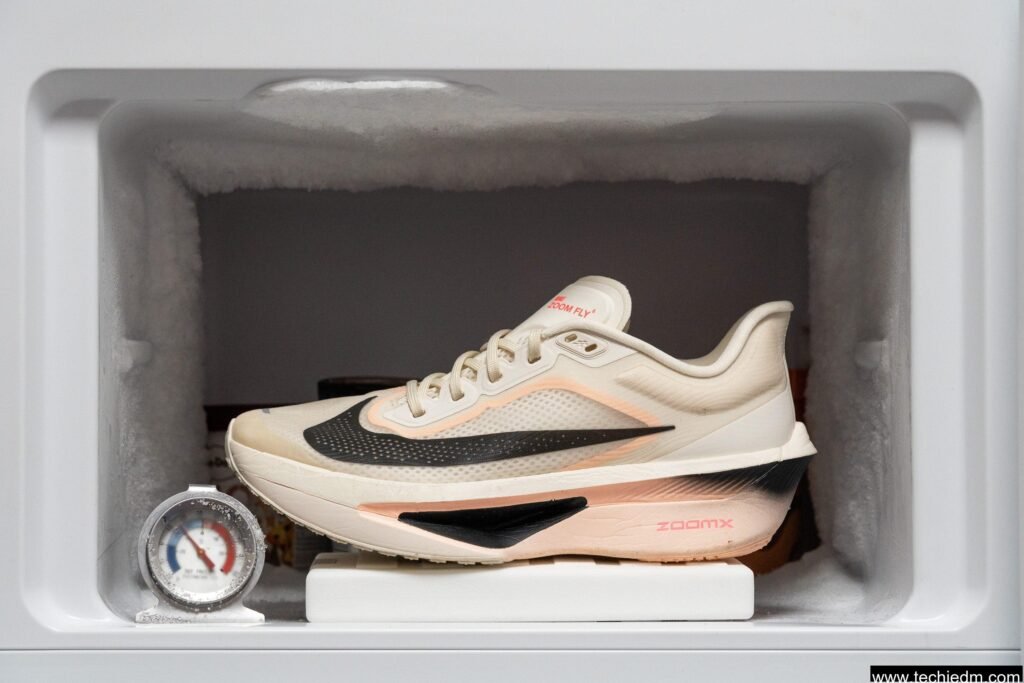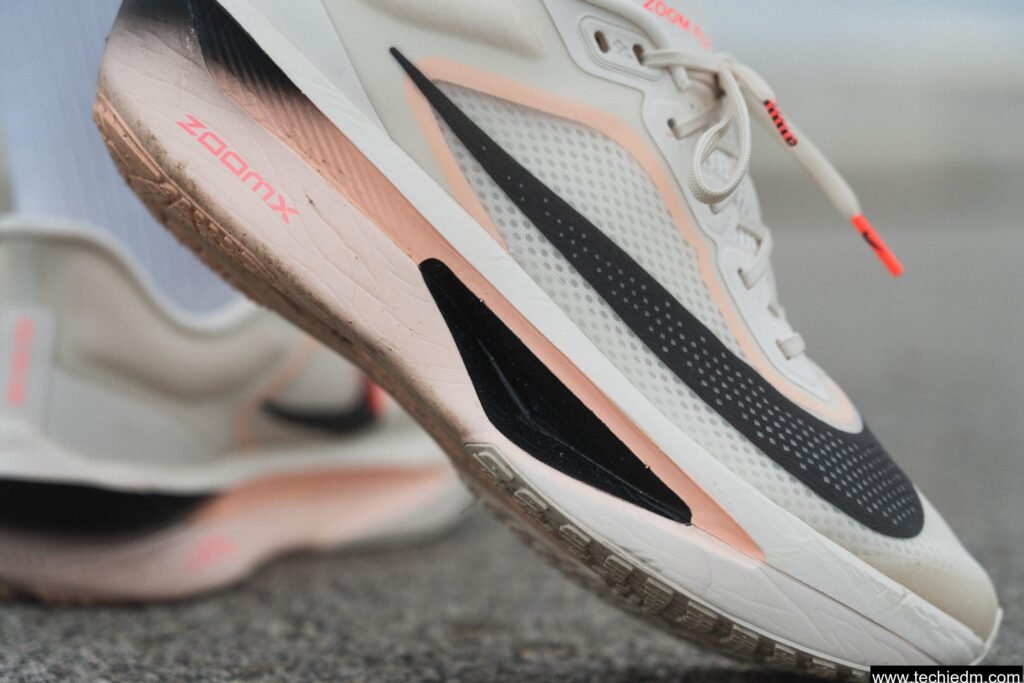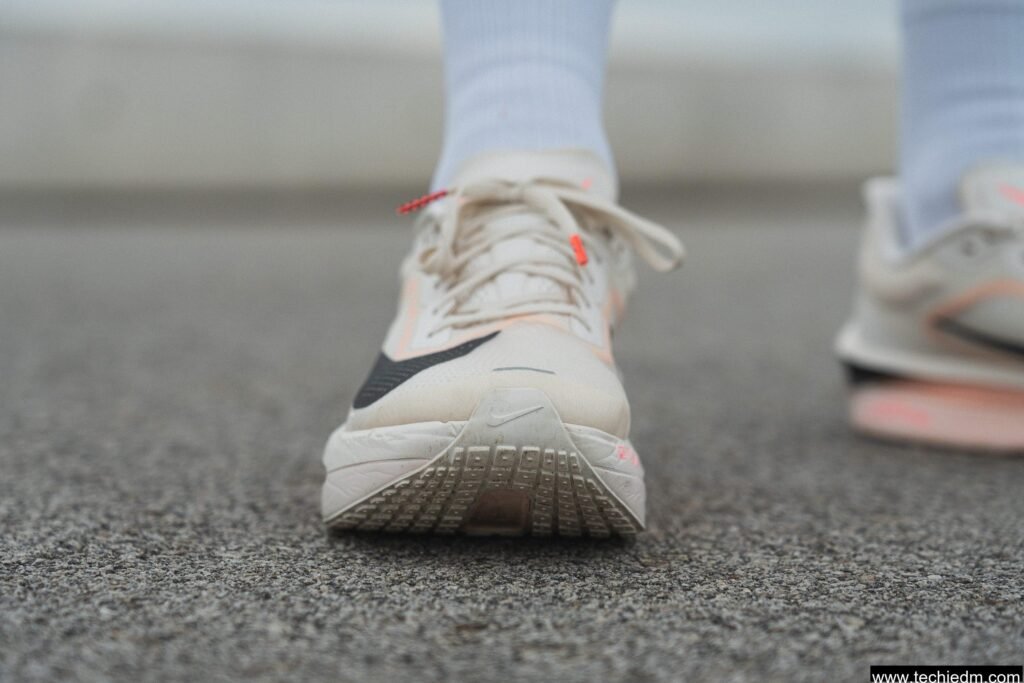
The City Wakes Up
There’s something electric about running through a city before it fully wakes up. The streets are mostly empty, painted in the cool blue of dawn. You hear your own breath, the rhythmic thud of your shoes on the pavement, and the occasional honk from a delivery truck.
I laced up the Nike Zoom Fly 6 at 5:45 AM. The air was crisp, a rare cool morning in late spring, and I had one goal: put these shoes through their paces on a real 10K city run. No treadmill, no track. Just me, the shoes, and the city.
First Impressions
Straight out of the box, the Zoom Fly 6 felt lighter than expected. The upper was sleek and breathable, with a snug fit that hugged my foot. The design screamed performance, streamlined, minimal, and purposeful. I noticed the carbon Flyplate peeking through an exposed cutout in the outsole, a visual reminder of the tech packed into this shoe.
I was a bit concerned about the narrow toebox. I have slightly wider feet, and while the length was spot-on, the width felt snug. But as I warmed up and jogged the first few blocks, the fit began to feel more secure than restrictive.
The Route

I started my run at the edge of downtown, heading east through the business district, weaving past quiet skyscrapers and shuttered cafés. From there, I curved along the riverfront, where the pavement shifted to a mix of asphalt and concrete. I finished with a steady climb through a hilly residential neighborhood before looping back.
This route is my go-to for testing shoes because it has everything: smooth flats, sharp turns, slight inclines, and a couple of grittier sidewalk patches.
Running Feel & Responsiveness
Let me say this clearly: the Zoom Fly 6 moves. Once I hit my stride, the ZoomX foam kicked in with a springy, energetic feel that made every step feel propulsive. The carbon plate added a snappy roll-through with each toe-off, especially noticeable when I picked up the pace on the flat river path.
At marathon pace (around 4:30/km), the ride was buttery-smooth. But what impressed me most was the versatility. I threw in a few 500m tempo surges, dipping under 4:00/km, and the shoe responded instantly, light, fast, yet cushioned enough to keep my legs fresh.
The rocker geometry really did its job. My transitions felt seamless, and I never had to think about my form or adjust my stride. It just flowed.
Comfort & Fit Over Distance
By kilometer 6, I usually start noticing pressure points or hotspots in new shoes. But with the Zoom Fly 6, nothing. The semi-gusseted tongue stayed in place, and the padding around the heel gave it that daily-trainer comfort I didn’t expect from a carbon-plated shoe.
However, the toebox remained narrow. If you have wide feet or hate snug fits, this might be a dealbreaker. I didn’t blister, but I definitely noticed the limited vertical space in the toe area by the 8K mark.
Grip, Stability & Noise

Here’s where things got interesting. On dry city pavement, the grip was fine, not exceptional, but reliable. I took a couple of tight corners at speed and never slipped, but I wouldn’t trust this outsole in wet conditions. It’s more road-racer than trail warrior.
Stability-wise, the shoe held up better than expected given its stack height. The carbon plate and flared heel design gave me enough support, though heel strikers who land off-center might feel a bit wobbly.
Worth noting: this shoe is surprisingly quiet. Some plated shoes slap the ground loudly, but the Zoom Fly 6 was stealthy, even on concrete.
Durability Check
Post-run inspection? No signs of wear. The outsole rubber showed no peeling or abrasion, and the upper looked pristine. The thick mesh and reinforced toebox seem ready to handle hundreds of kilometers.
I’ve worn plenty of supertrainers that felt amazing for 50K and then fell apart. This isn’t one of them. The Zoom Fly 6 looks and feels like it’s built to last.
Shoe Specs
| Feature | Detail |
|---|---|
| Weight | 248g (Men’s US 9) |
| Stack Height (Heel) | 39.7 mm |
| Stack Height (Forefoot) | 30.1 mm |
| Drop | 9.6 mm |
| Upper Material | Engineered Mesh with overlays |
| Midsole Foam | ZoomX + SR-02 |
| Plate | Full-length Carbon Flyplate |
| Outsole | Rubber with waffle-like pattern |
| Waterproofing | None (breathable mesh) |
| Grip | Moderate (0.42 traction rating) |
| Fit | Narrow toebox, true to size |
| Rocker | Yes |
| Breathability | Moderate (3/5) |
| Insole | 3mm, removable |
| Reflective Elements | Yes (heel and tongue) |
Final Thoughts
The Nike Zoom Fly 6 isn’t just a comeback, it’s a redefinition.
For runners looking for a high-performance trainer that borders on a racing shoe, this is a dream. It’s light, fast, durable, and surprisingly comfortable. The ZoomX foam and carbon plate deliver the kind of energy return and responsiveness usually reserved for $250 supershoes.
It’s not perfect, those with wide feet or stability needs may want to look elsewhere, but for neutral runners with a taste for tempo, the Zoom Fly 6 hits the sweet spot.
Would I race a half-marathon in these? Absolutely. Would I train in them three days a week? Yep. These shoes are more than hype, they’re built to run.
FAQs
Q: Is the Nike Zoom Fly 6 good for marathon training?
A: Yes. It offers enough cushioning and durability to handle long runs, with a responsive feel that keeps your legs fresh over distance.
Q: How does the Zoom Fly 6 fit?
A: It runs true to size, but the toebox is narrow and has limited vertical space. If you have wide feet, consider sizing up or looking for a wider model.
Q: Can I use the Zoom Fly 6 for racing?
A: Definitely. While not as aggressive as the Vaporfly or Alphafly, it’s fast and light enough for race day, especially if you’re running a 10K to half-marathon.
Q: How durable is the Zoom Fly 6?
A: Very. Both the upper and outsole performed excellently in durability tests, making it a great long-term investment.
Q: Is it waterproof?
A: No. The upper is breathable mesh, which allows airflow but won’t keep water out in rainy conditions.
Q: How does it compare to the Zoom Fly 5?
A: It’s lighter, more responsive, and finally uses real ZoomX foam. It’s a major upgrade in almost every way.
Q: Can I use orthotics with this shoe?
A: Yes, the insole is removable, but be cautious, there’s limited vertical space in the toebox that might make thicker orthotics uncomfortable.
Q: Is it good for beginners?
A: It can be, especially if you’re training for races. But casual runners may prefer a more stable, cushioned daily trainer to start with.
Leave a Reply